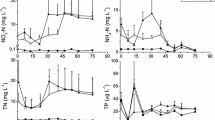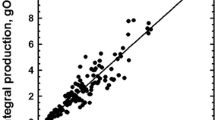Abstract
Three temple ponds with permanent blooms of blue green algae were highly productive. They all showed high alkalinity, hardness, electrical conductivity and pH. Organic carbon and nitrogen were highest in Sarvatheertham pond—60 to 79.6 mg./l. C and 4.10 to 7.60 mg./l. N. In Tamaraikulam it was 16.5 to 20.3 mg. C/l. and 1.03 to 1.32 mg. N/l. In Sarvatheertham, the gross production ranged from 2.85 to 20.72 g. O2/m.2/d. Self shading by blanket algae of blue greens reduced productivity in Sarvatheertham, where a persistent thermal and biochemical stratification was noted. Very high organic carbon and nitrogen contents were noted in Sarvatheertham pond. The dry weight of plankton in this pond ranged from 430 to 900 mg./l. Productivity computed from diurnal changes in alkalinity and dissolved oxygen also revealed a high rate in Ayyankulam, Tamaraikulam and Sarvatheertham in descending order. Very wide fluctuations in pH, both diurnally and depth-wise, were recorded in Sarvatheertham and to a lesser extent in the other two ponds. Photosynthetic efficiency was 4.03% in Ayyankulam, 2.09% in Tamaraikulam and 1.56% in Sarvatheertham. By the diurnal oxygen curve method, a gross primary production of 97.5 g. O2/m.2/d was recorded in Ayyankulam.
Similar content being viewed by others
References
Bartsch, A. F. 1960. ‘Algae in relation to oxidation processes in natural waters’. The Pymatuning Symposia in Ecology. Spl. Publ. No. 2 Pittsburg. 56–57. Ed. C. A. Tryon, Jr. and R. T. Hartman.
Copeland, B. J. & Dorris, T. C. 1962. Photosynthetcc productivity in oil refinery effluent holding ponds. J. Water Poll. Contr. Fedn. 34: 1104.
Daniels, F. 1956. Energy efficiencies in photosythesis in ‘Radiation Biology’ Vol. III, 259–292. Ed. A. Hollaender, McGraw Hill, N.Y.
Dunn, I. G. 1967. Diurnal fluctuations in physicochemical conditions of a shallow tropical pond. Limnol. & Oceanogr. 12 (1): 151–154.
Elster, H. J. 1962. Stoffkreislauf und Typologie der Binnengewässer als Zentrale Probleme der Limnologie. Naturwiss. 3: 49–55.
Fott, J. 1972. Observations on primary production of phytoplankton in two fish pond. Proc. IBP-UNESCO symp. on productivity problems of freshwaters. Warsaw (1970) 673–683.
Ganapati, S. V. 1940. The ecology of a temple tank containing a permanent bloom of Microcystis aeruqunosa (Kutz) Henfr. J. Bombay Natl. Hist. Soc. 41 (1): 65–77.
Ganapati, S. V. & Sreenivasan, A. 1972. Energy flow in aquatic ecosystems in India. Proc. IBP-UNESCO Symp. on productivity problems of Freshwaters (1970) 457–475.
Ganf, G. G. 1972. The regulation of net primary production in Lake George, Uganda, East Africa in ‘Productivity problems of Freshwaters’. Proc. IBP-UNESCO. Symp. Warsaw (1970): 693–708.
Goldman, C. R. & Wetzel, R. G. 1963. Primary productivity of Clear Lake, California, Ecology 44: 283–294.
Hepher, B. 1962. Primary production of fish ponds and its application to fertilisation experiments. Limnol. & Oceanogr. 7 (2): 131–136.
Holsinger, E. C. T. 1955. The plankton algae of three Ceylon lakes. Hydrobiologia 7: 8–24.
Hutchinson, G. E. 1957. Treatise on Limnology I. Wiley. 1–1019.
Khanna, Renu & Sinha, S. K. 1972. ‘Harvesting the sun’, Science Today 7 (3): 43–47.
Kimball, H. 1935. Intensity of solar radiation at the surface of the earth and its variations with latitude, longitude, season and time of day. Monthly Weather Review 63: 1.
King, Darrell, L. 1970. The role of carbon in eutrophication. Jr. Water Poll. Cont. Fed. 42 (12): 2035–2051.
Kuetzel, L. E. 1969. Bacteria, carbondioxide and algal blooms. Jr. Water Poll. Contr. Fed. 41 (10): 1737–1740.
Lagler, K. F. Bardach, J. E. & Miller, R. S. 1962. ‘Ichhyology’. Wiley, New York, 1–545.
Morgan, N. C. 1972. Productivity studies at Loch Levan (a shallow nutrient rich lowland lake). Proc. IBP-UNESCO Symp. on Productivity problems of Freshwaters, Warsaw. (1970) 183–205.
Nielsen, E. S. 1955. The production of organic matter by the phytoplankton in a Danish lake receiving extraordinary amounts of nutrients salts. Hydrobiologia 7: 63–64.
Oswald, W. J. & Golueke, C. G. 1960. Biological transformation of solar energy. Adv. appl. Microbiol. 2: 223–263.
Paasche, E. 1960. On the relationship between production and standing crop of phytoplankton. J. du Cons. 26 (1): 33–48.
Prowse, G. A. 1972. Some observations on primary and fish production in experimental fish ponds in Malaccia, Malaysia. Proc. IBP Symp. 555–561, (1970).
Prescott, G. W. 1960. Biological disturbances resulting from algae popuulations in standing waters. Spl. Publ. No. 2, Pymatuning Laboratory of Field Biology. 22–37.
Rodhe, W. 1958. Primärproduktion und Seetypen. Verh. int. ver. Limnol. 13 121–141.
Sreenivasan, A. 1964 (a). Limnological features of an primary production in a polluted Moat at Vellore, Madras State. Environmental Health 6: 237–245.
Sreenivasan, A. 1964 (b). The limnology, Primary production and fish production in a tropical pond. Limnol. & Oceanogr. 9 (3): 391–396.
Sreenivasan, A. 1964 (c). Limnological studies and fish yield in three Upland lakes of Madras State, India. Limnol. & Oceanogr. 9 (4): 564–565.
Sreenivasan, A. 1964 (d). Diurnal Oxygen Curve method for studying the productivity of waters. J. Marine Biol. Assoc. Ind. 6 (1): 167–168.
Sreenivasan, A. 1965. An instance of unusual oxygen production in a tropical impoundment. J. Marine Biol. Assoc. Ind. 7 (2): 469–471.
Talling, J. F. 1961. Photosynthesis under natural conditions. Ann. Rev. Plant. Physiol. 12: 133–154.
Talling, J. F., Wood, R. B., Prosser, M. V. & Baxter, R. M. 1973. The upper limit of photosynthetic productivity by photoplankton: evidence from Ethiopian soda lakes. Freshwat. Biol. 3 (1): 53–76.
Teal, J. M. 1962. Energy flow in a saltmarsh ecosystem. Ecology 43 (4): 614–62.
Weber, C. I. 1963. A study of photosynthesis in Clear Lake, Iowa. Proc. Iowa Acad. Sci. 70: 681–684.
Welch, H. E. 1968. Use of modified diurnal curves for the measurements of metabolism in standing water. Limnol. & Oceanogr. 13 (4): 679–687.
Wetzel, R. G. 1966. Variations in productivity of Goose and hyperautrophic Sylvan Lakes, Indiana. Invest. Indiana Lakes and Streams 7: 147–184.
Wright, J. C. 1961. The limnology of Canyon Ferry Reservoir. IV. The estimation of primary production from physical limnological data. Limno. & Oceanogr. 6: 330–337.
Author information
Authors and Affiliations
Rights and permissions
About this article
Cite this article
Sreenivasan, A. Limnological studies of and primary production in temple pond ecosystems. Hydrobiologia 48, 117–123 (1976). https://doi.org/10.1007/BF00040163
Received:
Published:
Issue Date:
DOI: https://doi.org/10.1007/BF00040163




